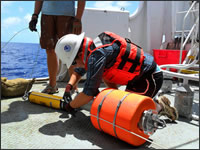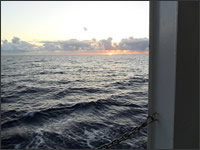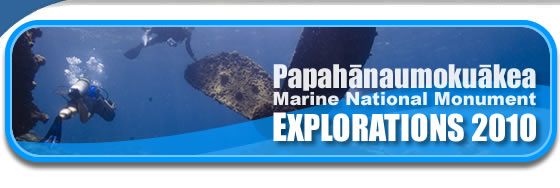Error processing SSI file
|
Mission Blog: May 12, 2010
Listening to the Deep
Anne Rosinski, Biologist, Hawaii Institute of Marine Biology
Today we arrived at our first destination in Papahanaumokuakea Marine National Monument – French Frigate Shoals.
 |
Biologist Anne Rosinski makes final preparations on the EAR before deployment off the Hi'ialakai.
(Photo: Nyssa Silbiger) |
I was very excited after two days of transiting in open ocean from Honolulu to see breaking waves and the outline of La Perouse Island in the distance. It meant we would begin the work we came to do with confidence after getting used to ship life and participating in safety briefings and drills where the ship crew showed their extensive knowledge and experience. First order of the day was to deploy a deep water Ecological Acoustic Recorder (EAR), from which we will obtain recordings of the sounds of marine mammals that inhabit these waters.
 |
The end of another productive work day, sunset near French Frigate Shoals. (Photo: Anne Rosinski) |
The EAR deployment required quite a bit of teamwork between me, the crew, and a crane to lift a heavy anchor that will bring the recorder to the ocean’s bottom, a release that will eventually send the EAR to the surface, and the EAR itself over the side of the ship. Once the EAR package was lowered to the water’s surface, we waited for confirmation from the ship’s captain that we were at the right location. After a few passes over the site, we received the OK signal and the EAR was released and we watched it gently sink out of sight. It will rest on the bottom and record marine mammal sounds for the next year until we return on the next cruise to the monument. This information will help us to create a clearer picture of what species of marine mammals are present and what their activities are within the monument.
Today was also the first day the scientists were able to get in the water. This is my first cruise to the monument and I was beyond excited to hear I would get a few hours to snorkel the maritime archeologist’s field sites. The archeology team and I were launched from one of the Hi’ialakai’s small boats and were soon hovering over a wreck that is thought to be an American whaling ship. It was particularly intriguing as a marine mammal scientist to be able to see large pots used to render oil from the whales, blubber hooks, and other whaling paraphernalia scattered along the reef. Marine mammals played such an important role in the human history of these islands, it is exciting to be able to return to these sites as a scientist and simultaneously learn about whales’ past and present influence on this area.
|



